HISTORY
PAPER – III
Note : This paper contains seventy five (75) objective type questions of two (2) marks each. All questions are compulsory.
1. Match List-I with List-II and select the correct answer with the help of the code given below :


2. Match List-I with List-II and select the correct answer with the help of the code given below :

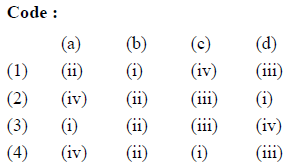
3. The earliest evidence of transition from hunting and food gathering to animal domestication and agriculture in Indian subcontinent has been found at :
(1) Anjira
(2) Damb Sadat
(3) Kile Gul Mohammad
(4) Mehrgarh
4. Given below are two statements, one labelled as Assertion (A) and the other as Reason (R)
Assertion (A) : Harrapan civilization was in close trade relations with South Turkmenistan.
Reason (R) : Harappan objects or those produced under Harappan influence have been found at Kish, Ur, Nippur, etc.
In the context of the above two statements which of the following is correct ?
(1) Both (A) and (R) are true and (R) is the correct explanation of (A).
(2) Both (A) and (R) are true, but (R) is not the correct explanation of (A).
(3) (A) is true, but (R) is false.
(4) (A) is false, but (R) is true.
5. The discovery of metal was a revolutionary event in human history. Richest copper mines occurred in which part of India ?
(i) Bihar
(ii) Gujarat
(iii) Rajasthan
(iv) Tamil Nadu
(1) (i) only
(2) (ii) and (iii) only
(3) (i), (ii) and (iii)
(4) (ii), (iii) and (iv)
6. Which Rigvedic deity is more frequently invoked as being the most useful as also the most fearsome of the gods ?
(1) Agni
(2) Dyaus
(3) Indra
(4) Marut
7. Which text makes it evident that the Vedic Sabha and Samiti were two separate institutions ?
(1) Aitareya Brahmana
(2) Atharva Veda
(3) Satapatha Brahmana
(4) Yajurveda
8. The followers of the Ajivika sect were also known by which other names ?
(i) Hatthapalekhana
(ii) Ekadandika
(iii) Magandika
(iv) Tedandika
Codes :
(1) (i) and (ii) only
(2) (i) and (iii) only
(3) (i), (ii) and (iii)
(4) (ii), (iii) and (iv)
9. Match List-I with List-II and select the correct answer with the help of the code given below :

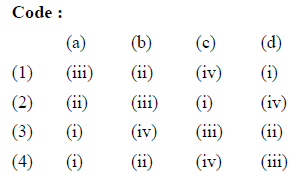
10. The ‘Indica’ of Megasthenes is lost, but it survives in fragments in the writings of which Greeco-Roman authors ?
(i) Ktesias
(ii) Pliny the Elder
(iii) Diodorus Siculus
(iv) Strabo
Codes :
(1) (i) and (ii)
(2) (i), (ii) and (iii)
(3) (ii), (iii) and (iv)
(4) (i) and (iv)
11. Which one of the following is not true about the Rummindei Pillar Inscription of Asoka ?
(1) It is located at Lumbini, a place Asoka had visited personally.
(2) It commemorates his visit to pay reverence to the Buddha Konakamana.
(3) Asoka made the village Lumbini free of the bali payments.
(4) He reduced its land revenue to one eighth.
12. Who visited the court of Bindusara as an envoy of the Syrian emperor ?
(1) Claudias
(2) Deimachus
(3) Diodorus
(4) Dionysus
13. Match List-I with List-II and select the correct answer with the help of the code given below :


14. The Mauryan army was comprised of
(i) Infantry
(ii) Cavalry
(iii) Chariots
(iv) Elephants
Code :
(1) (i) and (ii) only
(2) (i) and (iii) only
(3) (i), (ii) and (iii) only
(4) (i), (ii), (iii) and (iv)
15. Which of the following Tamil poets were associated with Kanchi ?
(i) Appar
(ii) Paranar
(iii) Mamulanar
(iv) Sundaramurti
Code :
(1) (i) and (ii) only
(2) (i) and (iii) only
(3) (i) and (iv) only
(4) (iii) and (iv) only
16. Harishena, the author of Prayaga Prasasti held which of the following offices ?
(i) Khadyatapakika
(ii) Kumaramatya
(iii) Mahadandanayaka
(iv) Sandhivigrahika
Code :
(1) (i) and (ii)
(2) (i) and (iii)
(3) (ii), (iii) and (iv)
(4) (i), (ii), (iii) and (iv)
17. Which among the following is the biggest Jaina image ?
(1) Monolithic image of Gommata at Shravanabelagola
(2) Parsvanatha image of Gwalior
(3) Jaina image in the Udaygiri caves
(4) Parsvanatha image of Bhojapur
18. Which of the following inscriptions of Samudragupta describe him as a ‘Parama Bhagavata’ ?
(i) Gaya Copper Plate
(ii) Nalanda Copper-plate
(iii) Eran Pillar Inscription
(iv) Allahabad Pillar Inscription
Code :
(1) (iv) only
(2) (i) and (ii) only
(3) (iii) and (iv) only
(4) (i), (ii) and (iv) only
19. Which new type of gold coins were started by Kumaragupta I ?
(i) Apratigha Type
(ii) Elephant Rider Type
(iii) Rhinoceros Slayer Type
(iv) Sword Type
Code :
(1) (i) only
(2) (i) and (ii) only
(3) (i), (ii) and (iii) only
(4) (i), (ii), (iii) and (iv)
20. Match List-I with List-II and select the correct answer with the help of the code given below :

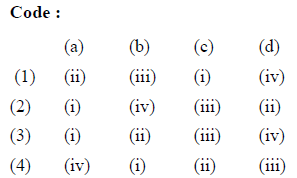
21. Apart from Harsha the Chinese traveller Yuan Chwang had occasion to meet which other contemporary rulers ?
(i) King of Gauda
(ii) King of Kashmir
(iii) King of Kanchi
(iv) King of Valabhi
Codes :
(1) (i), (ii) and (iii)
(2) (i), (iii) and (iv)
(3) (i), (ii) and (iv)
(4) (ii), (iii) and (iv)
22. Given below are two statements, one labelled as Assertion (A) and the other as Reason (R) :
Assertion (A) : The Pallava king Mahendravarman I, also known as Vichitra-Chitta, was a man of unstable mind.
Reason (R) : He professed Jainism for a time, but discared it in favour of Saivism
In the context of the above two statements which of the following is correct ?
(1) Both (A) and (R) are true and (R) is the correct explanation of (A).
(2) Both (A) and (R) are true, but (R) is not the correct explanation of (A).
(3) (A) is true, but (R) is false.
(4) (A) is false, but (R) is true.
23. Which among the following temples has a Dravidian type of Sikhara ?
(1) Ananta Vasudeva temple, Bhubaneswara
(2) Kandariya Mahadeva temple, Khajuraho.
(3) Lakshman Temple, Sirpur
(4) Teli ka Mandir, Gwalior
24. Which dynasty of South India claimed that its ancesters had ruled at Ayodhya ?
(1) Chalukyas of Kalyani
(2) Cholas
(3) Pallavas
(4) Rashtrakutas of Manyakheta
25. Sri Jaya Indravarman Maharajadhiraja of the Bhrigu family was the ruler of
(1) Champa
(2) Java
(3) Kambuja
(4) Pagan on Irawadi
26. Given below are two statements, one labelled as Assertion (A) and the other as Reason (R) :
Assertion (A) : Bhandarkar equates the Virashaiva with the Lingayat sect and traces its origin to a split in the Aradhya school of the Saivas.
Reason (R) : Acceptance of Brahamanical rituals and caste ascendency constitutes the core of the Lingayat movement.
In the context of the above two statements which of the following is correct ?
(1) Both (A) and (R) are true and (R) is the correct explanation of (A).
(2) Both (A) and (R) are true, but (R) is not the correct explanation of (A).
(3) (A) is true, but (R) is false.
(4) (A) is false, but (R) is true.
27. Consider the following statements about Fakhr-i Mudabbir and his Adab-ul Harb wa Shujaat.
(i) It is a work written on the science of warfare in the early years of Iltutmish’s reign.
(ii) Fakhr-i Mudabbir praises highly the swords made in India.
(iii) Mudabbir mentions that the iron was smelted at Khetri in Rajasthan.
(iv) He offers the earliest known description of the technique of producing Damascus steel.
Select the correct answer from the code given below :
(1) (i) and (iii)
(2) (iii) and (iv)
(3) (i), (ii) and (iii)
(4) (i), (ii) and (iv)
28. Given below are two statements, one labelled as Assertion (A) and the other as Reason (R) :
Assertion (A) : Sultan Zainul Abidin was a great patron of learning and surrounded himself with learned men with whom he was fond of holding discussions.
Reason (R) : Scholars like Saiyid Muhammad Rumi, Qazi Saiyid Ali Shirazi, Qazi Jamal and Saiyid Muhammad Sistani left their countries and emigrated to Kashmir during his reign.
In the context of the above two statements which of the following is correct ?
(1) Both (A) and (R) are true and (R) is the correct explanation of (A).
(2) Both (A) and (R) are true, but (R) is not the correct explanation of (A).
(3) (A) is true, but (R) is false.
(4) (A) is false, but (R) is true.
29. Consider the following statements on Ulugh Khan’s (Balban) relations with the Afghans ?
(i) Ulugh Khan recruited some 3000 Afghan into his army.
(ii) When Ulugh khan became sultan, he placed the newly created military outposts near Delhi such as Patyali, Kampil and Bhojpur under Afghan control.
(iii) Sultan Balban appointed Afghan noble Ikhtiyaruddin as wazir.
(iv) Sultan Blaban appointed several Afghans as governer.
Select the correct answer from the code given below :
Code :
(1) (i) and (ii)
(2) (ii) and (iii)
(3) (iii) and (iv)
(4) (i), (ii) and (iv)
30. The Sultan ordered , “Whatever they cultivate … should be assessed by measurement in accordance with yield per biswa, and all of them should pay half without any distinction.”
In the above statement which of the following Sultan had asked the measurement of land as the base of assessment ?
(1) Iltutmish
(2) Alauddin Khalji
(3) Muhammad Tughlaq
(4) Firuz Tughlaq
31. Which of the following statements about Amir Khusrau and his music are correct ?
(i) Amir Khusrau studied the Daccani music of the Karnataka School.
(ii) The great exponent of Deccani/ Karnataka music Naik Gopal was the contemporary of Amir Khusrau.
(iii) Amir Khusrau applaud’s his invention of sitar in his work Ghurrat al-Kamal.
(iv) Later works credit Amir Khusrau inventing about nineteen melodic forms, particularly khyal, tarana and qawl.
Select the correct answer from the code given below :
(1) (i) and (iii)
(2) (ii) and (iii)
(3) (ii), (iii) and (iv)
(4) (i), (ii) and (iv)
32. Given below are two statements, one labelled as Assertion (A) and the other as Reason (R) :
Assertion (A) : The Indian tradition regarding statecraft was not completely eclipsed with the coming of the Turks and continued in many peripheral areas.
Reason (R) : The writings of the Vijaynagara ruler, Krishnadeva Raya, Rajasthani Vigat and Khyat literature and Ramchandra Amatya’s Ájnapatra provide useful information on Indian statecraft.
In the context of the above two statements which of the following is correct ?
(1) Both (A) and (R) are true and (R) is the correct explanation of (A).
(2) Both (A) and (R) are true, but (R) is not the correct explanation of (A).
(3) (A) is true, but (R) is false.
(4) (A) is false, but (R) is true.
33. Naphta and Mangonels were used for the first time in India in which of the following place/region ?
(1) Sindh, 712
(2) Khajuraho temple, 950
(3) Deccan, 1130
(4) Panipat, 1526
34. From the following identify the place where Sultan Alauddin Khalji declared himself Sultan or ascended the throne :
(1) Awadh
(2) Delhi
(3) Allahabad
(4) Kara
35. Match List-I with List-II relating to terms and their meaning :
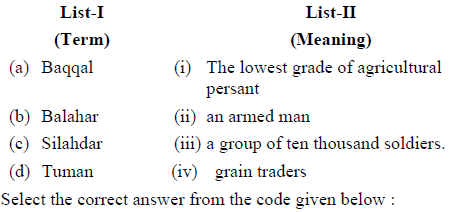
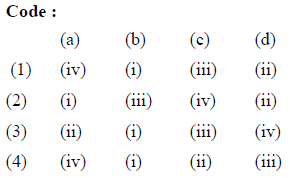
36. Which of the following sufi saints popularized the Qadiria order in Punjab and Sindh ?
(1) Shaikh Muhammad al-Husaini and Shaikh Abdul Qadir
(2) Shaikh Wajihuddin Ahmad and Shaikh Muhammad Ghaus.
(3) Shaikh Abdullah and Shaikh Qazin
(4) Shaikh Phul and Shaikh Burhanuddin
37. Given below are two statements, one labelled as Assertion (A) and the other as Reason (R) :
Assertion (A) : Muslim political thinking was also shaped by the Adab literature.
Reason (R) : The Adab literature was, to some extent, influenced by the Panchatantra which was introduced into Arabic literature by Ibn al-Muqaffa’s translation of Kalila wa Dimna.
In the context of the above two statements which of the following is correct ?
(1) Both (A) and (R) are true and (R) is the correct explanation of (A).
(2) Both (A) and (R) are true, but (R) is not the correct explanation of (A).
(3) (A) is true, but (R) is false.
(4) (A) is false, but (R) is true.
38. Which of the following pair (Author and Source) is not correctly matched ?
Author Source
(1) Nizam ud din Ahmad – Tabaqat-i Akbari
(2) Muhammad Kazim – Muntakhab-ul Lubab
(3) Abdul Hamid Lahori – Padshahnama
(4) Kewal Ram – Tazkirat-ul Umara
39. Which of the following is not correct ?
(1) Akbar divided his empire into twelve territorial units. These were called Subas.
(2) A Suba was divided into a number of Sarkars.
(3) A Sarkar was further divided into Parganas.
(4) A Pargana was further divided into Shiqs
40. Which of the following statements are correct ?
(i) The leading nobles and scholars such as the great litterateur, Khan-i Khanan Abd al Rahim, and the leading theologian, Shaikh Abd al Nabi were charged with responsibility for education of Prince Salim.
(ii) Well versed in Persian and Hindi and with a respectable knowledge of Turki, Prince Salim also possessed a good grounding in History, the natural sciences, geography, martial skills and theology which were considered appropriate for a prince.
(iii) Prince Shahjahan excelled in the martial arts. He possessed great military prowess.
(iv) Prince Shahjahan, who was born in Ahmadabad, ordered repairs to both Mughal and pre-Mughal buildings there, revealing a his interest in the maintenance of older structures.
Choose your answer from the code given below :
Code :
(1) (i) and (iii) only
(2) (i), (ii) and (iv) only
(3) (ii) and (iv) only
(4) (i), (ii) and (iii) only
41. Match List-I with List-II relating to Books and Authors :

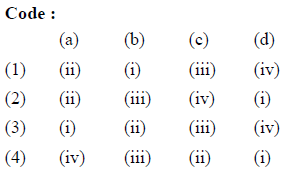
42. One of the innovation of the Mughals in building technology was pre-fab wooden structures. These portable homes were known as bangla in the seventeenth century from which the Anglo-Indian word ‘bungalow’ is derived. Which of the following Mughal emperor is credited with this innovation ?
(1) Akbar
(2) Jahangir
(3) Shahjahan
(4) Aurangzeb
43. Consider the following statements relating to various gaz used in the Mughal empire :
(i) Abul Fazl mentions that Humayun’s gaz-i Sikandari consisted of 32 angusht (digits)
(ii) Abul Fazl records that the length of gaz-i Ilahi was equal to 41 angusht.
(iii) The length of dira (gaz)-i Shahjani was equal to a little less than 33.5 angusht.
(iv) Tuzuk-i Jahangiri mentions the length of gaz-i Shar‘i as 26 angusht.
Select the correct answer from the codes given below :
(1) (i), (ii) and (iii)
(2) (i) and (iv)
(3) (ii) and (iv) (4)
(ii), (iii) and (iv)
44. Given below are two statements, one labelled as Assertion (A) and the other labelled as Reason (R) :
Assertion (A) : The European trade in indigo became very important in the first half of the seventeeth century, after which it experienced a sharp decline.
Reason (R) : There was rise in the price of Agra indigo and the competition from the slave-worked plantations established in the West Indies.
In the context of the above two statements which of the following is correct ?
(1) Both (A) and (R) are true and (R) is the correct explanation of (A).
(2) Both (A) and (R) are true, but (R) is not the correct explanation of (A).
(3) (A) is true, but (R) is false.
(4) (A) is false, but (R) is true.
45. Which of the following statements is not correct ?
(1) Sarrafs (money changers) specialized in issuing hundis to enable remittances to be made.
(2) Hundi was a negotiable document, usually transferred at a small discount.
(3) A single rate of ‘exchange’ was fixed for bills drawn at one place upon another irrespective of remittance or credit.
(4) The hundi itself specified whether it was to be payable on sight, or payable at the end of a particular period after its presentation to the drawee.
46. Which of the following statements are correct ?
(i) There was tradition of an annual ‘sarbat khalsa’ at Chak Guru (Amritsar); but dissensions grew apace and each chief tended to carve out a separate territory for himself.
(ii) The Dasam Granth contains compositions of Guru Gobind Singh.
(iii) The Gurus were Khatris and their principal lieutenants, the masands, were also Khatris.
(iv) The military power of the Gurus reached its apex under the tenth and last Guru, Gobind Singh.
Select your answer from the code given below :
Code :
(1) (i), (ii) and (iv) only
(2) (ii) and (iii) only
(3) (i), (iii) and (iv) only
(4) (i) and (iii) only
47. Which of the following statement is not correct ?
(1) Persian was not only the language of higher administration in the Delhi Sultanate and the Mughal empire, but had also spread to the courts of the Rajput states.
(2) Sirajuddin Ali Arzu propounded the view that Persian and Hindi had fundamental affinities.
(3) Tek Chand Bahar quotes poets and prose-works in his Bahar-i Ajam which was written in 1639-40.
(4) A new language Urdu, sprang from the interaction of Persian with Hindi dialects.
48. Given below are two statements, one labelled as Assertion (A) and the other labelled as Reason (R) :
Assertion (A) : Jean de Thevenot, a French traveller writes that the people of Surat commonly do not drink the water of Tapti river.
Reason (R) : The water of river was brackish.
In the context of the above two statements which of the following is correct ?
(1) Both (A) and (R) are true and (R) is the correct explanation of (A).
(2) Both (A) and (R) are true, but (R) is not the correct explanation of (A).
(3) (A) is true, but (R) is false.
(4) (A) is false, but (R) is true.
49. Consider the following statements pertaining to customs rates in the Mughal empire :
(i) Abul Fazl mentions that  cent was the maximum customs duties under Akbar.
cent was the maximum customs duties under Akbar.
(ii) In Jahangir’s reign customs duties were![]() cent on all imports and exports of
cent on all imports and exports of
goods.
(iii) In Shahjahan’s reign customs duties were 2 per cent on money either gold or silver.
(iv) Aurangzeb fixed a higher custom rates for non-muslims. That is why Muslim merchants smuggled goods belonging to Hindus to evade higher customs rate.
Select the correct answer from the code given below :
Code :
(1) (i) only
(2) (ii) and (iii)
(3) (iii) and (iv)
(4) (i), (ii) and (iv)
50. Given below are two statements, one labelled as Assertion (A) and the other labelled as Reason (R) :
Assertion (A) : When Nizam ul Mulk arrived in the Deccan as the Viceroy in 1714, he refused to accept Daud Khan’s agreement for the payment of the Chauth and Sardeshmukhi of the Deccan to Shahu.
Reason (R) : Nizam ul Mulk inflicted a couple of defeats on them, and destroyed the small mud forts which they had built in every district and which served as a base of attack or a place of refuge to the Maratha bands.
In the context of the above two statements which of the following is correct ?
(1) Both (A) and (R) are true and (R) is the correct explanation of (A).
(2) Both (A) and (R) are true, but (R) is not the correct explanation of (A).
(3) (A) is true, but (R) is false.
(4) (A) is false, but (R) is true.
51. When and where the ‘Society for Translating European Sciences’ was set up ?
(1) Bombay in 1825
(2) Pune in 1830
(3) Calcutta in 1825
(4) Lahore in 1824
52. Match List-I with List-II and choose correct answer from the code given below :
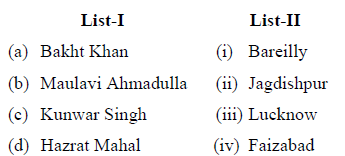

53. Given below are two statements, one labelled as Assertion (A) and the other labelled as Reason (R) :
Assertion (A) : The decline of the traditional handicraft cottage industries was the result of British commercial policy.
Reason (R) : The imperialist conquests had given immerse resources to the British.
In the context of the above two statements which of the following is correct ?
(1) Both (A) and (R) are true and (R) is the correct explanation of (A).
(2) Both (A) and (R) are true, but (R) is not the correct explanation (A).
(3) (A) is true, but (R) is false.
(4) (A) is false, but (R) is true.
54. Given below are two statements, one labelled as Assertion (A) and the other labelled as Reason (R) :
Assertion (A) : The Liberals genuinely believed that there was a constitutional way to India’s self rule.
Reason (R) : They had an abiding faith in the British senses of justice.
In the context of the above two statements which of the following is correct ?
(1) Both (A) and (R) are true and (R) is the correct explanation of (A).
(2) Both (A) and (R) are true, but (R) is not the correct explanation (A).
(3) (A) is true, but (R) is false.
(4) (A) is false, but (R) is true.
55. Given below are two statements, one labelled as Assertion (A) and the other labelled as Reason (R) :
Assertion (A) : According to Vivekanand : “Caste system is opposed to the religion of the Vedanta.”
Reason (R) : All evil comes from relying upon differences. All good comes from faith in equality, in the understanding of the underlying sameness and oneness of things.
In the context of the above two statements which of the following is correct ?
(1) Both (A) and (R) are true and (R) is the correct explanation of (A).
(2) Both (A) and (R) are true, but (R) is not the correct explanation of (A).
(3) (A) is true, but (R) is false.
(4) (A) is false, but (R) is true.
56. Who among the following had not been involved in floating the idea of permanent settlement for Bengal ?
(1) Alexander Dow
(2) Thomas Law
(3) Montgomery Martin
(4) Philip Francis
57. Arrange chronologically the following tribal rebellions :
(a) Rampa
(b) Santal
(c) Kol
(d) Munda under Birsa
Select the correct answer from the codes given below :
Codes :
(1) (b), (c), (a), (d)
(2) (c), (b), (a) (d)
(3) (d), (a), (c), (b)
(4) (b), (d), (c), (a)
58. Who among the following were revolutionary leaders ?
(a) Barkatulla
(b) Khizar Hayat Khan
(c) Obeidulla Sindhi
(d) Mahmud Hasan
Select the correct answer from the code given below :
Code :
(1) (a), (b) and (c)
(2) (a), (b) and (d)
(3) (b), (c) and (d)
(4) (a), (c) and (d)
59. In which session of the Indian National Congress, a policy about the princely states was first time enunciated ?
(1) Nagpur, 1920
(2) Tripura, 1939
(3) Haripura, 1938
(4) Karachi, 1931
60. In which session, Congress passed the resolution of ‘Poorna Swaraj’ ?
(1) Lahore Session
(2) Calcutta Session
(3) Madras Session
(4) Lucknow Session
61. Which one of the following organizations was established in 1942 by the leftiest women leaders in Bengal ?
(1) Mahila Sudharna Samiti
(2) Mahila Samajwadi Samiti
(3) Mahila Suraksha Samiti
(4) Mahila Atmarakshan Samiti
62. Who among the following was the first Indian women President of Indian National Congress ?
(1) Aruna Asaf Ali
(2) Sucheta Kirpalani
(3) Sarojini Naidu
(4) Latika Ghosh
63. Match List-I with List-II and choose correct answer from the code given below :

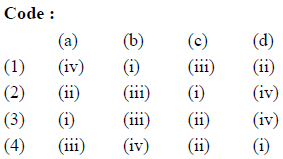
64. Khudai Khidmatgars were popularly known as the ___________
(1) Green Shirts
(2) Red Shirts
(3) Black Shirts
(4) White Shirts
65. Aryasamaji leader Mr.Harvilas Sarada belonged to which part of India ?
(1) Rajasthan
(2) Maharashtra
(3) Gujarat
(4) Punjab
66. Which area’s communists launched a massive campaign with the slogan ‘Throw the American model into the Arabian sea’ ?
(1) Area of Nagpur State
(2) Area of Nizam state
(3) Area of N.W. Travancore state
(4) Area of Bhagalpur
67. The most militant struggle was the Tebhaga struggle by the Share-croppers of Bengal. They declared that they would not pay __________ of the crop to the landlords.
(1) 1/3
(2) 1/4
(3) 1/6
(4) 1/2
68. In which year the National Congress passed a resolution calling upon the Indian people ‘to refrain from the use of Japanese goods’ ?
(1) 1936
(2) 1937
(3) 1938
(4) 1939
69. Arrange the following events in chronological order :
(a) Subhash Chandra Bose had a meeting with Mr. Tojo.
(b) Subhash Chandra Bose arrived at Taipei.
(c) INA hoists the National Flag on the free Indian soil.
(d) Establishment of Indian National Army.
Select the correct answer from the code given below :
Code :
(1) (d), (a), (c), (b)
(2) (d), (c), (a), (b)
(3) (d), (a), (b), (c)
(4) (d), (b), (c), (a)
70. Who said the following ‘invoke the aid of the almighty to take me away from this ‘vale of tears’ rather than make me a helpless witness of the butchery by men become savage, whether he dares to call himself a Muslim or Hindu or what not’ ?
(1) M.K. Gandhi
(2) Abdul Gaffar Khan
(3) Vinoba Bhave
(4) Maulana Abul Kalam Azad
71. Who among the following described the redistribution of provinces on linguistic basis as ‘assassins of nationalism’ ?
(1) K. M. Munshi
(2) Sardar Vallabhbhai Patel
(3) Jawaharlal Nehru
(4) Jamanalal Bajaj
72. Which one of the following was not an aspect of the official policy of ‘Apartheid’ ?
(1) Racial Segregation.
(2) Separate but equal development of the Africans.
(3) Laws prohibiting mixed marriages.
(4) Patronizing native culture of the Africans.
73. Match List-I with List-II and choose correct answer from the code given below :

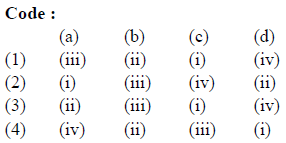
74. Who among the following expressed grave doubts about Ranke’s tall claim regarding ‘objective’ and ‘impartial’ history ?
(1) George Waitz
(2) E.H. Carr
(3) Heinrich Von Sybel
(4) Dove
75. In which year the ‘non-proliferation’ treaty was signed ?
(1) 1956
(2) 1963
(3) 1982
(4) 1990
Latest Govt Job & Exam Updates: